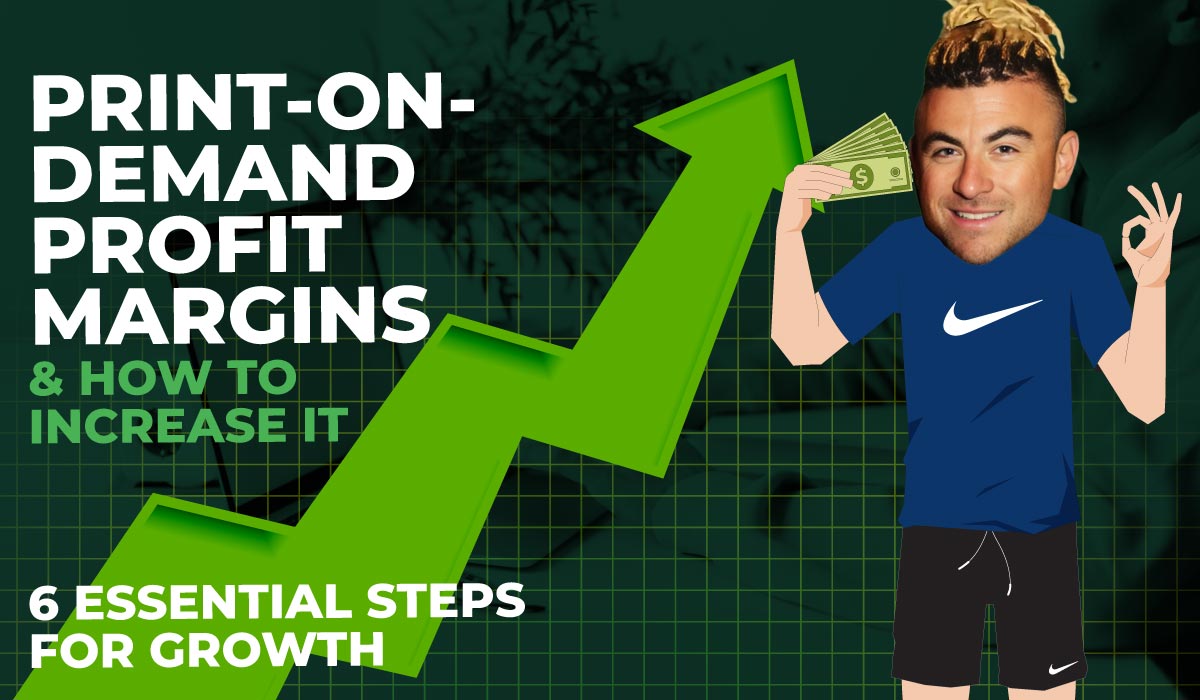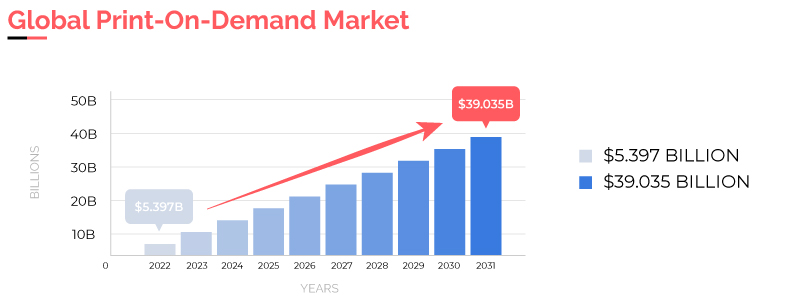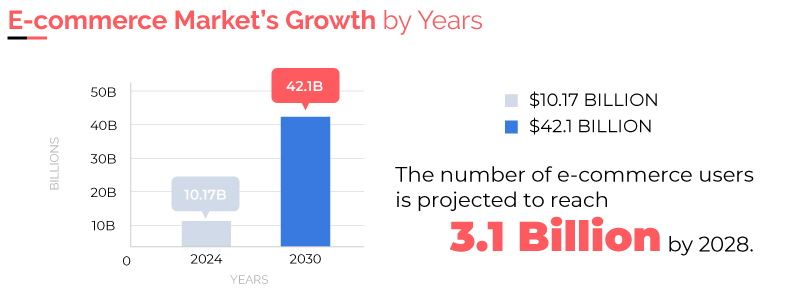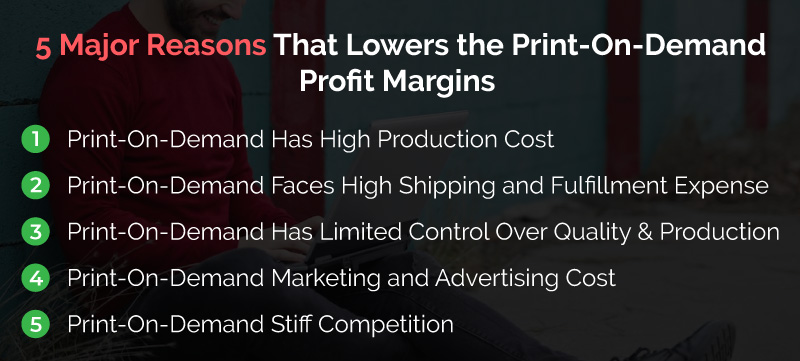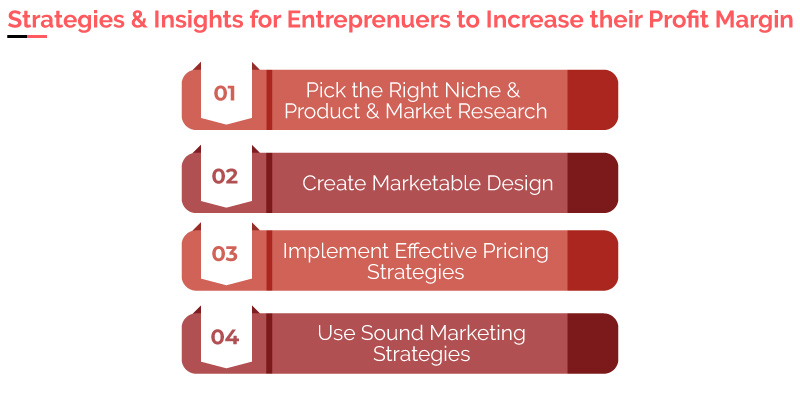
Print-on-demand profit margin is usually between 15%-60% on average, according to Teeinblue. Printify said that their sellers make about 20% profit margin, while some profitable products have a higher profit margin of 40% to 60%. A good profit margin for print-on-demand is anything between 30% to 50% of your revenue, according to Printful. Margins below 15% can be risky because they don't allow you to cover operational costs and marketing. Also, a high profit margin above 60% makes it difficult to sustain your print-on-demand business unless you offer unique or premium products.
People from Reddit have varied experiences with print-on-demand profitability. The margins are as low as 10% to as high as 70%-100% depending on the product, strategy, and platform. Users highlight challenges such as competition, high fees, and visibility on popular platforms. Some find success in this passive income by targeting specific niches or moving sales to their websites to reduce costs and increase profit margins.
In this article, we will look at good profit margins for print-on-demand, ways of increasing it and calculating profit margins. We will also compare print-on-demand with another business model profit, and reasons that lower POD profit margins. Lastly, let us check other model alternatives to print-on-demand.

How To Increase Profit Margins On Print-On- Demand?
1. Optimize Print-On-Demand Product Selection
Optimizing print-on-demand product selection is important to increase your profit margin. Targeting a specific niche will help you distinguish your print-on-demand business from competitors. Here’s how you can do it:
In addition, there has been a growing demand for sustainability products and evergreen niches over the years. ComCap reports that one in every five customers (20%) will pay over 20% for personalized products. Also, the 2021 Statista survey found that 27% experimented with new products because of sustainability. Moreover, approximately 25% will invest more in sustainable fashion.

In his YouTube video, Charlie Chang talks about how AI and e-commerce will revolutionize print-on-demand business models. He highlights how AI tools like ChatGPT and MidJourney can uncover top-selling POD products within your niche that can increase profit margins.
He uses ChatGPT to generate relatable and niche-targeted text. It can be inspirational phrases and business quotes that are tailored for specific audiences. For example, med students and entrepreneurs. He then uses MidJourney to create captivating images aligned with the textual themes. Charlie believed that AI-generated content can boost your creativity and market relevance.
2. Set Your Print-On-Demand Pricing Correctly
Setting your print-on-demand pricing is crucial for maximizing your profit margins. Correct pricing strategies affect your profitability. They determine your margin per sale and influence the customer's perception of your POD products. With a good pricing strategy, you can position your print-on-demand products against competitors and capture a larger market. on your
Statistically, pricing has a significant impact on both sales volume and profit margins. A study by McKinsey & Company revealed that a 1% increase in price if volumes remain constant, can lead to an 8.7% increase in operating profits. If you set prices too high without a clear benefit, you may experience a drop in sales and reduced profitability. Underpricing your products to attract more sales can decrease profit margins in the long run.

7 Factors In Setting Print-On-Demand Pricing For Higher Profit Margins

A YouTube video from Jay of the Fixed Point channel discussed the perfect pricing strategy to maximize profit on Etsy. He recommends using Printify as a print-on-demand order fulfillment provider because it works well with Etsy and offers various products. He pointed out that by subscribing to Printify's $29 monthly plan, sellers can buy print-on-demand products at a significant discount. Jay recommends adjusting both the product price and shipping costs on Etsy to achieve a higher profit margin.
He shared his breakdown of pricing a t-shirt at $25. He included the cost of the shirt, Etsy listing fees, transaction fees, and processing fees, resulting in a total cost of $16.57 and a profit of $8.43 per shirt. Moreover, he also said pricing less popular product options (e.g., a white, small t-shirt) with lower prices can help increase sales volume. However, the profit margin on those specific sales is smaller. Jay also suggested setting a fixed shipping price that can cover the cost of multiple items in a single order without losing profit.
3. Enhance Your Print-On-Demand Design Quality and Uniqueness

One way of increasing your profit margin is by enhancing the quality and uniqueness of your print-on-demand designs. The demand for personalized and unique products has driven the print-on-demand industry's growth. According to Straits Research, analysts expect the global print-on-demand market to reach $39.035 billion by 2031. This is a huge jump from $5.397 billion in 2022, showing there's a clear trend toward custom products. ComCap said 36 % of consumers want personalized products and 48% will wait for customized items.
Monitor trends using social media platforms like Facebook, Instagram, TikTok, and Pinterest. By looking at what is trending or gaining enough attention, you can get inspired to create new designs that have huge potential to sell to your target audience. You may use Google Keyword Planner and Google Trends to identify trending topics or search queries related to your niche. Design tools, like Canva, have easy-to-use templates for creating high-quality and unique designs.
Here are some POD design trends in 2024, according to Printful:
Pattern: This includes soft to bold, light to dark patterns, and eye-catching fashion trends. Examples are gothic florals, ombre and gradient, grungy plaid, and groovy designs.
Maximalism: Characterized by colorful and mismatched prints. It includes fun colors, eye-catching designs, and accessories.
Coordinated Prints: These are pieces that work well together. It includes monochrome sets, matching pairs, and layering.
Quiet Luxury: These are timeless designs with modern take to elevate the basics. It gives high-end rich-looking wearables.

YouTuber Money With Mak is a seasoned digital entrepreneur with a focus on e-commerce. She said it's important to have standout designs in competitive marketplaces like Etsy or Amazon to generate a good profit margin.
For beginners, Mak suggested starting with text-based designs. This is because of their simplicity and potential for impact. The key lies in using unique fonts, which beginners can source from sites like dafont.com and Creative Fabrica. However, she also stressed the importance of proper licensing to avoid copyright infringement.
Mak also recommends using specific color combinations to make designs stand out. She suggested finding color schemes and color palettes that are currently trending to your target audience. Also, Mak recommends using Placeit.net to produce professional designs, logos, and mock-ups. Despite being a paid service, Mak says the investment can lead to increased sales.
4. Streamline Your Print-On-Demand Operations To Reduce Costs
Streamlining your print-on-demand operations can increase your profit margin as a business owner. It reduces the costs and enhances the efficiency of your operation. Here’s how you can streamline your POD operations:


In a YouTube video posted by Ben Smith in 2023, he shared how he organized and streamlined his print-on-demand business. He starts with a central organizational file on his computer, where he keeps essential details about each product such as title, brand, descriptions, tags, product colors, design IDs, publication statuses, and platforms uploaded.
Ben organizes his design and those from his designers in one Google Drive folder sorted by date. A significant timesaving hack Ben uses is the Productor. It is a free Google Chrome extension for Merch by Amazon that allows him to export all his product data and designs from Merch by Amazon into an Excel sheet and local folders. This sheet includes detailed information about each design. It has the optimal product colors (with hex codes), design IDs, publication status on different platforms, and more.
To further automate the process, Ben uses POD Connect. It is a tool that helps automate uploading designs to various platforms like Printful, Etsy, and Seller Central. This process ensures efficiency in managing his POD business across various platforms.
5. Expand Your Print-On-Demand Sales Channels and Marketing
To increase your profit margin, you need to expand your print-on-demand sales channel and marketing. The U.S. Small Business Administration advises to allocate 7 to 8 % toward marketing and advertising efforts. By using effective marketing techniques, you can reach a broader audience. Here are the different ways to do it:


Robert Delins explored paid and free advertising strategies to help boost product awareness. He experimented with Facebook, Instagram, and TikTok ads. Robert finds Facebook ads complex but rewarding with good impressions and a low cost per click of around 20-40 cents.
Moreover, he mentioned that Instagram ads are simpler but cost more around $1-$2. For him, TikTok ads have mixed effectiveness and cost. Furthermore, he mentioned that Pinterest advertising offered more detailed targeting options. However, it can be overwhelming for beginners. Robert also said that influencer advertising on Instagram proved effective and cost-efficient.
For free advertising, he recommends using social media, particularly TikTok. It has viral potential and cross-promotion opportunities with Instagram. He also advises advertising based on available time and budget. He highlights that as the brand and social media followings grow, depending on paid advertising can decrease. This allows for more organic reach and sustained sales.
6. Prioritize Customer Satisfaction and Retention
In the print-on-demand business, providers create products only when there is a demand. So, focusing on customer satisfaction and retention is a critical strategy to increase profit margins. In this line of business, it is important to keep customer satisfaction high. One negative review can affect your brand’s image, which can deter potential customers and lead to customer abandonment.
A PwC survey found that 73% of consumers value the quality of their purchasing experience. This indicates that high-quality products enhance customer satisfaction. Shineon, a print-on-demand store in Shopify, posted on X that 79% of buyers say that user-generated content (UGC) influences their decisions

Use different customer retention strategies, such as:
offering referral programs
providing targeted and personalized campaigns
listening to customer feedback
engaging customers with relevant content
optimizing customer service
and rewarding loyal customers.
These strategies not only increase the lifetime value of customers but also enhance customer loyalty and the overall customer experience.

Shimmy Morris uploaded a video on YouTube, explaining how one can still make profits in a competitive print-on-demand landscape. He gave a breakdown of the cost of producing a basic t-shirt, ranging from $8.14 for basic colors to $12.64 for more varied hues. Shimmy estimated that the advertising cost per sale is around $10.
He recommended a selling price range between $20 and $25, with a target profit margin of $3 to $5 per shirt. Moreover, he stressed that creating designs with viral potential is important to stand out from competitors. He also estimates that it might take between five to ten attempts, with a testing budget of $25 or 30 clicks per design. The goal is to identify a successful design without exceeding the budget of $125 to $250.
How Can You Calculate Profit Margins For Print-On-Demand Products?
You can calculate the profit margin for print-on-demand products by following these steps:
- Calculate the overall production cost: Add all expenses related to creating one unit of your POD product. This includes printing, packaging, shipping, platform fees, and more.
- Set the desired profit margin: Start by deciding the percentage of profit you aim for each sale. The general recommendation is between 30%-50% above the production cost.
- Calculate the selling price: You may use the formula below:

4. Calculate the actual profit margin: Use the formula below:

For instance, if you sell a custom t-shirt for $25, and the base cost to produce and ship the t-shirt is $15, your profit would be $10 per shirt. To calculate the profit margin, divide the profit ($10) by the selling price ($25) and multiply by 100 to get a profit margin of 40%.
In addition, there are many Etsy Calculators available online that can help you calculate your profit margins.

Anji Martin posted a video about her fail-proof formula for pricing her print-on-demand products on platforms like Etsy. She suggested using Sale Samurai, an Etsy SEO analysis and keyword tool. Initially, she researched the average market price by searching terms like ‘women's sweatshirt’ or ‘mug’ in Sale Samurai. It gives insights into the top listings on Etsy, along with the average price and shipping cost. She then checked the cost of producing and shipping the item using Printify.
Next, she went to the Sale Samurai profit calculator and input the following details to calculate the profit margin:
- Retail Price: The average total price (product + shipping) that similar items sell for on Etsy. For example, $39.99 for a sweatshirt or $24.99 for a mug.
- Material Cost: The cost of producing the item, as provided by Printify. For example, $18 for a sweatshirt or $4.63 for a mug.
- Shipping Cost: The fee for shipping the item to the customer, also provided by Printify. For example, $8 for a sweatshirt or $4.99 for a mug.

If you are a premium member of Printify, which offers the product at a lower cost, the profit margin could be around $15. Here is another computation for the cost of a duffle bag from Printify using print-on-demand profit calculator for Etsy:

3 Awesome Facts That Print-On-Demand Still Has Decent Profit Margin
1. Print-On-Demand Has Low Overhead and Inventory Costs
Print-on-demand still has decent profit margin because it remains an appealing business because of its low overhead and inventory cost. Since it has minimal upfront investment there is still potential for profit. This business model eliminates the need for upfront investment, reducing the financial risk. Here’s a breakdown of the possible costs in opening a print-on-demand store:

The initial setup could range from $100 to $500. These costs can increase based on the scale and scope of your marketing efforts and whether you opt for paid tools or services or not.
2. Print-On-Demand Allows Global Reach

Print on Demand continues to offer decent profit margins which can be seen from its global reach. E-commerce offers global reach and access to a wider target audience with lower upfront costs compared to traditional models. According to Precedence Research, the e-commerce market is expected to exceed $10.17 billion in 2024. It is estimated to surpass $42.1 billion by 2030. The number of e-commerce users is projected to reach 3.1 billion by 2028, representing about 40% of the anticipated global population.
Straits Research reports that the global POD market, which was worth $5.397 billion in 2022, is forecasted to surge to $39.035 billion by 2031. It is exhibiting a Compound Annual Growth Rate (CAGR) of around 26.2%. This growth is supported by technological advancements and platforms integrated with e-commerce stores. This simplifies the process of selling on a global scale.
3. Print-On-Demand Has Diverse Product Offerings
Print-on-demand has diverse product offerings. This ranges from apparel and accessories to home décor and other custom products. Having many POD products without holding inventory reduces upfront costs and risks of unsold goods. This allows you to experiment with different products and adapt to market trends or seasonal demands. Here’s a sample catalog from Printify offering a wide range of product:

Grand View Research forecasts that the apparel sector, particularly custom t-shirts, will expand at an 11.1% CAGR until 2030, while the home décor segment is anticipated to experience the quickest growth due to a rising consumer focus on personalizing their living environments.
What Does Reddit Say About Print-On-Demand Profit Margins?
People from Reddit said that the print-on-demand profit margin is from as low as 10% to as high as 70%-100% for specific niches. This means that its profitability can differ based on the product, platform, and strategy. The discussions on Reddit also identified some drawbacks of using popular POD platforms. This includes intense competition, high transaction and subscription fees, and visibility challenges. Some users have found success by creating their websites and driving traffic.
A Reddit thread by Mugzhawaii said that print-on-demand profit margins are so low. This is because Printify print and shipping fees are so expensive. This was answered by Ux_rachel saying that to earn with print-on-demand, you need to cut out the middleman. This is often Printify since you can sell the same product for a reduced price using Etsy and Shopify. She added that she targeted a very specific audience (parents looking for back-to-school bundle items) and listed every single item in her store for double its cost unless it is a sale.


AyurvedaYogaforLife also added that to increase profit margin and sales, you need to increase the price of your products. He said that he used his designs on higher-margin products such as t-shirts and hoodies, and changed POD suppliers. No_Department8358 and TheGeekYouNeed both advised increasing your prices to increase your profit margin. Moreover, remember that POD will always have a lower profit margin. But, the advantage is not investing a huge amount of money, managing inventory, and shipping products. BornWillow shared that in his experience, raising the price increased his sales. Comatoast1 said that to increase profit margin in print-on-demand, you need to make better designs so you can charge more.

In another Reddit thread, UpsetTop said that he is currently earning about 10% from his POD sales minus the Prinful, Etsy, and other fees. PassiveAsha said that she is earning 40% using the same platforms. Sara-pod makes a 70%-100% profit margin from selling personalized engraved bracelets. Similarly, mzdebo earned 60% from using Printful and selling everything from shirts to cups to shoes through her website. Ifourth said that he earned a 20% profit margin from selling bracelets.

MyMeltingBrain thinks that after Etsy fees and shipping, it is impossible to make a profit. Sirius_moonlight shared that he watched some videos on YouTube from the Handmade and Beyond channel that earned only $2-$4 a shirt. TheRealBritishOn said that making a decent profit with print-on-demand comes down to the designs and pricing. Also, selling higher-priced products makes more money than t-shirts and mugs.

Similarly, SoCalChic18 designed shirts through Printful and earned a profit of under $2 after all the fees. Such-Macaron_65 said that Printify charged $23 to make a shirt and Etsy takes a 10% cut. He also noted that he needs to sell his shirt for $50 to hit a 50% profit margin, which is quite expensive.

Chiefginja said that a 50% profit margin is too high and in his experience, she sets her margin anywhere from 35%-55% before Etsy fees. Peaceful-Plantpot also shared that his usual profit margin is at 28%. Next-Cartographer-28 explained that he cut Etsy and created his website and drove his traffic. This is because Etsy is over-flooded with everything, making it hard for everyone to make a decent sale. Moreover, Etsy only shows the top sellers on the front page and their ads are questionable.

Naravyn shared that she uses Redbubble because they don't charge per listing as Etsy does. But, there is still no money there, and she isn’t happy with the profit. She tried Teespring, but still no sales because you have to drive the sales yourself. She then tried Printify and Etsy. The margin is 5% of the sale, then 3% plus 0.25 transaction fees, plus the listings cost of 0.20 each. She tried to open a pop-up shop on Printify with no additional costs past the fees. However, you can't edit it past what each listing says. She created an FB page for her shop and posted her designs there. She advised not to set up e-commerce because it cuts into your margins.
When pricing her print-on-demand products, she tries to keep her prices consistent instead of getting a flat percentage on everything so the prices won’t vary for the same item. However, in doing this kind of pricing, some products will have less profit margin than the others. In addition, she suggested that you look at various suppliers because others might be better than shirts but another is good for hoodies. She also said that she makes her margins a little lower than the 40% suggested by Printify. Lastly, she advised that you do your research on anything you plan on spending money on, and don't be afraid to try free stuff to see if it works for you.

From the testimonies above, many said that the high cost of production and shipping fees by POD platforms like Printify can eat into profit margins. To address this and increase profit margin, people from Reddit suggested the following:
cutting out middlemen to have more control over pricing and reduce costs
targeting specific audiences
using an effective pricing strategy
focusing on high-margin products
exploring different print-on-demand suppliers
increasing product prices
creating better and unique designs
Print-On-Demand Profit Margins VS Other Business Models
Comparing print-on-demand profit margins with different business models provides insight into the potential of each venture. However, you have to note that these models vary in terms of cost, potential, operations, and demand. Here is the breakdown of each model in terms of profit margin:

BUSINESS MODEL
PROFIT MARGIN
NOTES
Print-on-Demand
20%-50%
Profit margins vary on production costs, product pricing, and niche. Margins are higher for unique, niche-specific products. But, it is lower compared to holding your inventory of products.
Dropshipping
15%-20%
Profit margins can be thinner because of high competition and low barriers to entry. However, profit margin can improve with specific niche products and effective marketing.
Affiliate Marketing
5%-50%
The model has different commission structures across industries. High-ticket items or niches can offer higher percentages. It requires minimal investment but depends on high traffic and conversion rates.
Amazon FBA
15%-20%
Amazon fees, shipping costs, and competition can affect Amazon's FBA profit margin. Amazon has a large customer base, but the cost can eat into your profit margins. You need effective inventory management and product selection to succeed.
Is Print-On-Demand Profitable?
Yes, print-on-demand is profitable. Many entrepreneurs find success in the field by offering unique designs, using targeted marketing strategies, and choosing high-margin products. Gelato mentioned that, on average, you can earn a monthly profit of $4639 to $9833. According to Printify, it usually takes 165 days to hit their first $1000 on average. Printify also said that sellers make a 40%-50% profit margin. Also, 24% of print-on-demand shops are still up and running after three years. According to Keywords Everywhere and Google Trends, print-on-demand has a high monthly global search volume of over 200,000.
What are high margin print-on-demand products?
High-margin print-on-demand products are items that yield a larger percentage of profit. Gelato suggests high-margin products, such as:
- custom apparel
- kids' clothing
- accessories
- drink wares
- home decor
- and tech items.
5 Major Reasons That Lowers The Print-On-Demand Profit Margins

1. Print-On-Demand Has High Production Costs
Print-on-demand has high production costs that can lower your profit margin. These costs come from manufacturing each item upon order. While it eliminates the risks of unsold inventory, it takes higher per-unit posts compared to bulk manufacturing.
Manufacturing and shipping costs can fluctuate with production volume. While subscriptions to eCommerce platforms, POD suppliers and marketing expenses remain fixed regardless of sales volume. Here’s a production cost comparison of the top print-on-demand products from Printify and Printful:
PRODUCTS
PRODUCTION COST (PRINTIFY)
PRDUCTION COST (PRINTFUL)
T-Shirts
$9.58-$34.40
$6.45-$29.50
Hoodies
$20.34- $61.70
$20.25-$53.50
Sportswear
$15.67-$38.81
$6.50 -$53.50
Eco-friendly products
$11.49 -$226.61
$16.50 - $59.95
Stationery
$2.54-$21.82
$1.50 - $12.95
Drinkware/Mugs
$4.40-$19.37
$6.75-$19.75
Hats
$11.72-$14.18
$13.25-$26.25
Wall Art/Decor
$3.06-$226.61
$6.25-$29.50
Home decor
$4.48-$42.07
$10.95-$28.95
Tech accessories
$7.31-$44.70
$8.75-$18.25
Take note that when you subscribe to Printify Premium for $29 per month, you get a 20% discount on all products.
2. Print-On-Demand Faces High Shipping and Fulfillment Expense
Print-on-demand faces high shipping costs and fulfillment expenses that cause a low-profit margin. Shipping and fulfillment expenses are part of the overhead costs. This is deducted from the total revenue to determine the net profit. These costs depend on the shipping destinations, product sizes, and fulfillment methods. With high shipping, you need to adjust your pricing so it remains competitive.
Addressing high production costs in POD is crucial for maintaining a good profit margin. Here are some strategies to manage and reduce these costs:
Here’s a sample breakdown of the shipping rate from Printful for shirts:

Printify also offers different shipping rates per Printify Print Providers.
3. Print-On-Demand Has Limited Control Over Quality and Production
In print-on-demand, you have limited control over the quality and production of the products. This is because you rely on print-on-demand platforms to manufacture and ship products to your customers. Some platforms offer better print quality than others. Additionally, the provider might offer a limited range of products for POD services.
In addition, sellers have limited control over the supply chain, production methods, printing quality, and packaging. You can't dictate the quality of ink, the materials used, the accuracy of the printing, the resolution, the colors, and how long the product lasts. This leads to inconsistent quality across products.
Moreover, delays in shipping can damage your brand's reputation. For example, according to a survey by BrightLocal, 91% of consumers mentioned that reviews affect their view of a store or brand. With 88% more likely to buy from brands that respond to all reviews. Additionally, 77% of shoppers visit at least two or more sites to read business reviews.
4. Print-On-Demand Marketing and Advertising Costs
Print-on-demand marketing and advertising costs can lower the profit margins. This is because they increase the total expenses associated with selling a product. Especially if the campaigns do not target the audience or if it is high compared to the profit per product. With the increasing number of print-on-demand entrepreneurs, advertising expenses have risen. Avoiding these costs may prove challenging. Hubspot Blog Research identified social media as the marketing channel giving the highest return.
To mitigate the impact of marketing and advertising costs on profit margins, POD businesses can use these strategies:

5. Print-On-Demand Stiff Competition
The print-on-demand industry has a stiff competition, which can affect profit margins. The intense competition is because of the low barrier to entry into the POD space. Moreover, print-on-demand is cost-effective and low-risk.
It primarily requires establishing a digital shop for your designs, which is often little to no expense. With POD, you can avoid concerns about excess inventory or financial loss. This is because you only manufacture products when orders are placed. Additionally, you have the freedom to create unlimited designs without incurring extra costs.

Here are several strategies and insights that entrepreneurs can use to increase their profit margins.
What's the Difference Between the Print-On-Demand Profit Margins and Local Lead Gen Biz?
The difference between the print-on-demand profit margin and the local lead generation profit margin is big. On average, the profit margin for print-on-demand is between 15% to 60%. Since POD involves selling low-priced items, you need to sell a lot to make a decent income. Furthermore, creating products only when there is demand results in higher production costs. This lowers the profit margin compared to competitors who have purchased inventory in bulk.
In contrast, local lead gen businesses often boast higher profit margins, commonly ranging between 85% to 90%. Local lead generation requires minimal operational costs compared to handling physical products. With no inventory, shipping, or manufacturing, the overheads are lower. This contributes to higher profit margins.
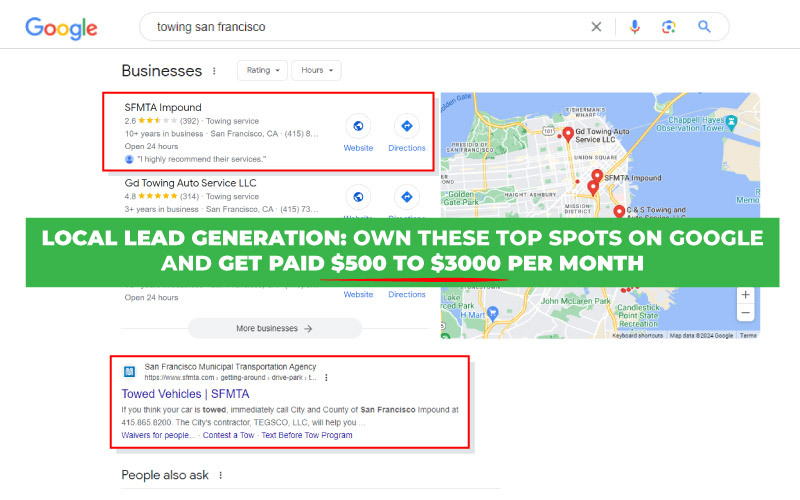
With print-on-demand, you need to deal with product design, production, and shipping (even if outsourced). These things can contribute to lower profit margins. Local lead gen focuses on digital marketing strategies to capture and sell leads. Print-on-demand faces intense global competition while local lead gen has less competition. This is because local lead generation focuses on serving the specific needs of local businesses. Both business models offer unique opportunities and challenges. But if you are looking for a less competitive market offering higher profit margins, local lead generation is for you.



